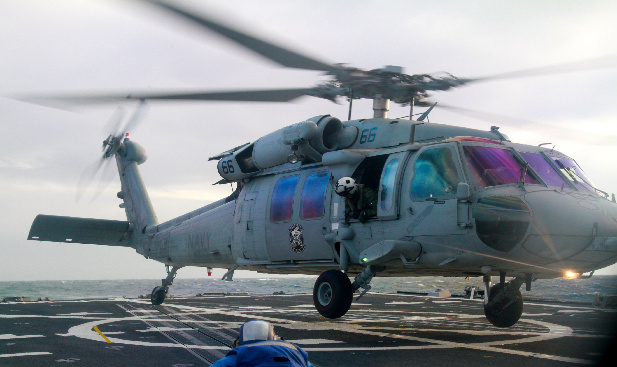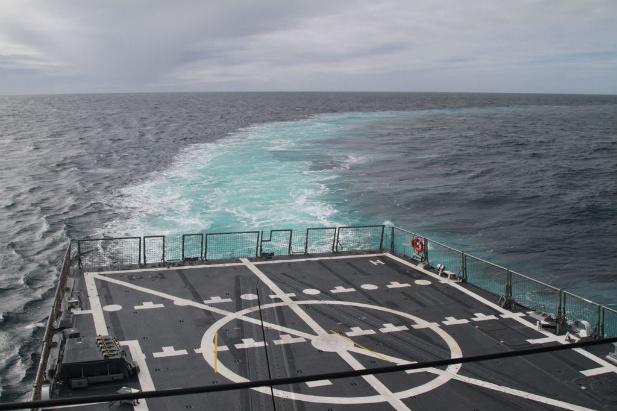This is Part II of a series. Part I can be read HERE
I arrived at the parking lot at 5:40AM and within ten minutes five others did the same. Moments later, a Navy Master Chief in the new navy camouflage uniform approached us and had us drive our cars past a Marine guarded gate into a secure area. Soon we were in a van to the headquarters of the US Navy Naval Surface Forces, Pacific where we had an orientation meeting and group photo. Quickly we were back into the van and within minutes arrive at NAS on the other side of the island.
We entered a nondescript one story building where we anxiously looked out to the tarmac at a row of Seahawk helicopters, wondering which would be our ride. In less than five minutes one taxied to within fifty yards of the building and a pilot and crewman climbed out of the aircraft and came into the building to speak with us. What we got was a professional, routine, concise and clear pre-underway checklist of things to do, not do and expect. What we felt was anything but routine. None of us had ever flown on a helicopter and we were about to take off and fly about 100 miles due west into the Pacific and land on the small flight deck of a destroyer underway. We were issued helmets, life jackets and airsickness bags. Part of our orientation was what to do in case of a water landing and, more specifically, what to do when the helicopter turns upside down (the craft is top loaded due to the weight of the engine) and fills with water. While my brain listened intently to the instructions regarding finding an orientation point to hang on to, releasing the seat belt, opening the door or window and exiting to float to the surface, my mind was envisioning very dark and disturbing thoughts.
We had the opportunity to take a few photos and then walked out to board the helicopter single file. I had the coveted ‘gunner’s seat’, an outward facing seat right behind the co-pilot with my own window. (I was told to enter the helicopter by climbing through that window) The real fun was about to begin. The Seahawk is the Navy version of the more famous Blackhawk helicopter. It has a twin turboshaft engine, generally has a crew of 3-4 and can carry an additional 6 or more passengers. This is a versatile workhorse, capable of flying over 500 miles, carrying a myriad of weapons from torpedoes (yes, torpedoes!), missiles and machine guns. I didn’t ask about gas mileage but at 17,000 pounds loaded, it probably is something less than a Prius.
It was loud but in an exhilarating way. We slowly lifted off the ground without any sensation of movement, continued to gain altitude and the helicopter’s nose dipped just a little as we headed out to sea. I expected more vibration and bouncing but the ride was quite smooth and comfortable in the unsettled weather, albeit a little chilly.
About 40 minutes into the trip we started to descend, closer and closer to the white caps on the water. It was only during the last 10 seconds that I saw what we were landing on, a pitching and rolling flight deck of a ship making about 14 knots. Once the flight crew had us literally chained to the flight deck, we were led off the helicopter, across the edge of the deck, into the hangar and then into the Ward Room where the Captain, Executive Officer and Master Chief greeted us with smiles and hot, strong coffee.
The Captain gave us a thorough orientation of the day’s activities and encouraged us to ask any questions at any time to any person on any topic. You can’t expect more than that and our group started with questions covering all topics including technology, weapons, and even internet access. All questions were promptly and enthusiastically answered. This Navy of ours is a very open, transparent and engaging organization. Not a single question went unanswered, not a single request unfulfilled.
The weather outside had taken a turn towards the decidedly uncomfortable and when the Ensign assigned to conduct our tour said we could stay inside rather than venture out, the group answered that we didn’t care about getting wet, we wanted to go out on deck, and so we did.











